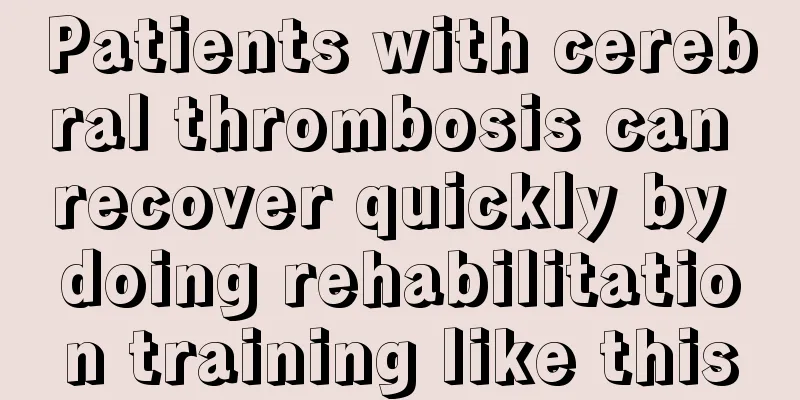Patients with cerebral thrombosis can recover quickly by doing rehabilitation training like this

|
Cerebral thrombosis is a common and frequent disease, which usually requires rehabilitation training to assist in treatment when the disease enters a stable state. Sitting balance training, standing balance training, walking training, stair climbing and wheelchair use training are five simple and effective rehabilitation training methods. Patients with cerebral thrombosis can learn more about them so as to recover their health as soon as possible. 1. Sitting balance training First, bend your knees and sit on the bed with the support of the back frame, gradually remove the support, and put your legs on the edge of the bed. You can also install rails, handles or ropes on the side or head of the bed to help you sit up. Sitting balance training enhances trunk muscle strength (simultaneous contraction) and sitting balance, etc. 2. Position balance training Need support or train on a special double pole, using a cane if possible. When standing, keep your feet about 3 cm apart. First use the healthy limb to hold the weight, then slowly try to use the affected limb, gradually alternating the two feet until you stand firmly. You can also hold on to a stool or other tools and slowly move and walk. 3. Walking training Initially supported by others, gradually transition to walking independently, while paying attention to correcting problems during walking, such as the circular gait of hemiplegic patients. The main movements during training are knee flexion and ankle dorsiflexion. Choose a lighter and tougher crutch with an appropriate length, generally 3 to 5 cm from the armpit to the sole of the foot, or the patient's height minus 40 cm. You can also use a pair of crutches. It depends on the individual and the appropriate length. 4. Stair climbing training When going upstairs, first step up with your healthy foot and then lift your affected foot to the same step as your healthy foot. Do the opposite when going downstairs. If you use crutches, you can first place the crutches on the upper step, then step over with your healthy foot, and finally step over with your affected foot. The movements are the opposite to going downstairs. Sometimes you may feel uneasy when going downstairs, so you can try going downstairs facing backwards. 5. Wheelchair training Initially, the patient is supported and assisted by someone. The assistant stands behind the wheelchair, holds the armrests or back of the wheelchair with both hands, and then steps on the horizontal axis below with his feet to fix the wheelchair. The wheelchair is placed on the patient's healthy side, and the handbrake is engaged when getting up or down. After getting on, the patient is trained to move on the chair, moving forward and backward and rotating left and right. |
<<: I feel a sense of anal drooping and always want to go to the toilet. What's going on?
>>: What to do if anal rupture and bleeding
Recommend
How to eat mustard without choking
Mustard is something that people both love and ha...
How long should the Chinese medicine belly button patch be applied
Chinese medicine navel patches are usually pasted...
What to do if the nose is darker than the face
If the nose is darker than the face, you should p...
Symptoms of pharyngitis, acute and chronic should be distinguished
Pharyngitis can be acute or chronic, and this dis...
Why does chest tightness occur when the wind is strong?
When it is windy outside, people may experience c...
Symptoms of polychondritis
Polychondritis often occurs in the ear area, caus...
Is colon cancer hereditary?
Intestinal cancer is one of the most common malig...
The height of the pillow determines the length of life
Guoguo has seen many people have soft and comfort...
How do you get urethritis
After suffering from urethritis, the symptoms wil...
What are the ointments for treating acne?
Acne is also called acne. Generally, women will h...
What vitamins are missing for hangnails on hands
Hangnails are a symptom that many people experien...
Do you know the early symptoms of skin cancer?
Early stage skin cancer often presents as erythem...
How long to boil black tea
Chinese tea ceremony is very famous in the world....
What are the complications of hypertension? The seven most obvious symptoms
Surveys show that hypertension has become a commo...
How much is the baby's weight and height at 40 days?
When the baby is 40 days old, that is, shortly af...









